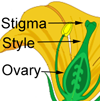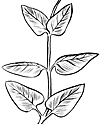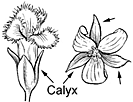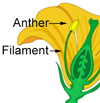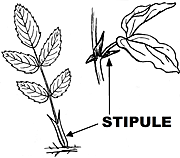Noni
Morinda citrifolia
Madder family (Rubiaceae)
Native species (indigenous)
This small tree of moist lowlands, especially in gullies, apparently was introduced by the early Hawaiians. It is characterized by paired large elliptical shiny dark green leaves, many small white tubular flowers in ball-like clusters, and whitish or yellowish egg-shaped or elliptical multiple slightly resembling small pineapples, fleshy and malodorous.

©2006 Forest And Kim Starr
Leaves hairless, with stout green leaf-stalks of about 1⁄2 inch (13 ) and paired rounded () about 1⁄4 inch (6 ) long at base of each pair, leaving ring scar upon shedding. Blades 5–11 inches (13–28 ) long and 2 1⁄2–6 1⁄2 inches (6–16.5 ) broad, not on edges, thin, with sunken curved side veins, upper surface shiny dark green, and lower surface light green with small tufts of hairs in vein angles along
Flower clusters (heads) are elliptical or rounded, about 1 inch (25 ) wide, light green, mostly single on stalks of 1⁄2 inch (13 ) above leaves. Flowers are many, crowded, united at base, more than 1⁄2 inch (13 ) long. Base () more than 1⁄8 inch (3 ) long, light green, with very short light green rim; white, nearly 1⁄2 inch (13 ) long, tubular with 4–6 3⁄8–1⁄2 inch (10–13 ) across; 4–6 3⁄16 inch (5 ) inserted near mouth of tube; and composed of inferior two-celled with slender light green and two-
Multiple (syncarp) from flower head is a compact soft juicy mass 3–4 inches (7.5–1 0 ) long and 2 1⁄2 inches (6 ) broad, with warty surface. Individual 1⁄2 inch (13 ) across, 4–6-sided, each two-celled and two-seeded. Seeds more than 1⁄8 inch (3 ) long. Flowering and fruiting nearly through the year.
Wood bright yellow or yellow-brown, soft, fine-textured and straight-grained. Not used in Hawaii.
This species was grown by the Polynesians and Hawaiians for dyes. Red for coloring tapa or bark cloth was obtained from the bark and yellow from the trunk and roots. The with fetid cheese-like odor and insipid or unpleasant taste were eaten raw or cooked and were fed to hogs. Juice from the as an insecticide was an ingredient in a hair shampoo. Leaves, bark, and were used in folk remedies.
The English name painkiller refers to use of the leaves in the Virgin Islands, Trinidad, Guyana, and probably elsewhere in alleviating pain. According to different directions, a hot leaf (heated over a fire) or wilted leaf is pressed against the body on painful swellings, a poultice of the leaves is applied to wounds or to the head for headaches, or crushed leaves in lard or camphor oil are put on the face for treatment of neuralgia or head colds.
This small tree is sometimes used as an ornamental. A variety with variegated leaves ( citriodora var. potteri Deg.) is occasionally cultivated. It was introduced from Fiji by Degener in 1941.
Planted and naturalized in lowlands to 1500 ft (457 ) through Hawaii, especially in moist small valleys and pockets of soil in lava rocklands, also frequent in sandy coastal areas. Perhaps on old home sites.
Special areas
Waimea Arboretum, Bishop Museum, Haleakala, Volcanoes
Range
Native of India, Malaya including East Indies, and tropical Australia and introduced into other tropical areas. Cultivated and in part naturalized through West Indies including Puerto Rico and Virgin Islands and in Guianas. Rarely planted at Key West, Florida.
Other common names
Indian-mulberry, painkiller, morinda, gardenia hedionda, noni (Puerto Rico); lada (Guam, N. Marianas); ngel (Palau); lol (Yap); nen (Truk); weypul (Pohnpei); ee (Kosrae); nen (Marshalls); nonu (Am. Samoa)
The lightweight seeds have an air-sac and may have been disseminated along beaches by floating.
Hawaii has two native species of Morinda, called noni kuahiwi (meaning noni of the mountains): Morinda sandwicensis Deg., Hawaiian morinda, of Oahu, and Morinda trimera Hillebr. on Oahu, Maui, and Lanai.
